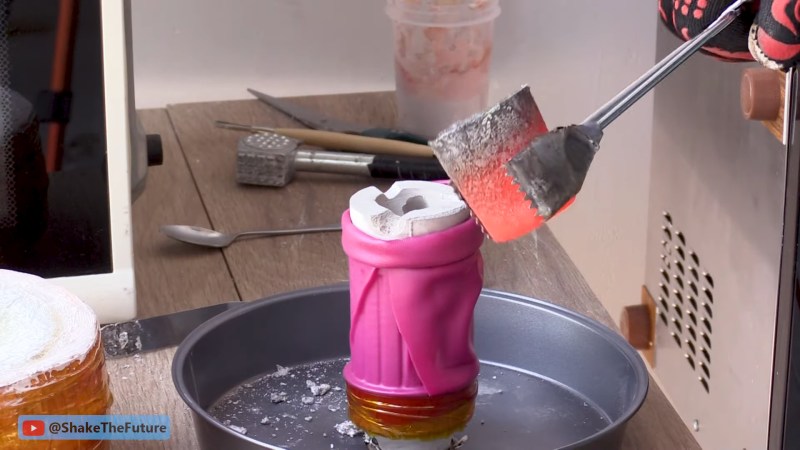Hacks are rough around the edges by their nature, so we love it when we get updates from makers about how they’ve improved their process. [Denny] from Shake the Future has just provided an update on his microwave casting process.
Sticking metal in a microwave certainly seems like it would be a bad idea at first, but with the right equipment it can work quite nicely to develop a compact foundry. [Denny] walks us through the process start to finish in this video, including how to build the kilns, what materials to use, and how he made several different investment castings using the process. The video might be worth watching just for all the 3D printed tools he’s built to aid in the process — it’s a great example of useful 3D prints to accompany your fleet of little plastic boats.
A lot of the magic happens with a one minute on and six minutes off cycle set by a simple plug timer. This allows a more gradual ramp to burn out the PLA or resin than running the microwave at full blast which can cause some issues with the kiln, although nothing catastrophic as demonstrated. Vacuum is applied to the mold with a silicone sleeve cut from a swimming cap while pouring the molten metal into the mold to draw the metal into the cavities and reduce imperfections.
We appreciate the shout out to respirators while casting or cutting the ceramic fiber mat. Given boric acid’s effects, [PDF] you might want to use safety equipment when handling it as well or just use water as that seems like a valid option.
If you want to see where he started check out this earlier version of the microwave kiln and how he used it to make an aluminum pencil.

















OK… so I’m not totally against videos but they aren’t a great way to explain things. In this case, a video exceeding a full hour is just obscene. Seriously, a paper with illustrations and maybe a few demonstration videos is all that is needed. I understand why entertainers like this make these absurdly long videos but I’m not going to watch them just to learn something that is better in written form.
I don’t excercise the patience to make either, so to learn some skill or craft from the efforts of someone that has put the time into teaching said skill is valuable. I want to explore microwave casting, so watching an hour of well done instruction can save me frustration. If i were not interested in doing but rather just looking for entertainment, the option would then be mine to watch or not.
I definitely agree: while I’m not usually into video format as it can be lengthy (like instruction video for consumer product) and I favor text/image as it can be quickly skimmed, this video about video casting on other hand, covers an impressive range of instructions. If you are willing to do it at home, that’s definitely a valuable material and time spent watching it. Good job!
If you want 10s (min) entertainment short video, the web is full of it.
Concur. The video is well done and provides a lot of information and tips. Complaints without providing a better real alternative or hypothetical solutions are as useful as gelded studs.
The issue is that you have an hour-long video attached to a short form article, which sets the expectations wrong. You have to watch the video for maybe half an hour just to determine that you’re not all that interested in the finer points of kapton tape and just want to see the guy pour some metal.
In such cases, a highlights reel or a little bit more depth in the article would go down better. Now it’s like, “Hey, here’s an interesting little story – but I’m not going to talk about it in any appreciable detail. Go check out War and Peace by Leo Tolstoy. I’m sure you’ll like it.”
You should watch it. He’s captivating and walks you through plenty of expert issues and workarounds. Maybe you should try to do more instead of less.
Well said.
Yeah but then how do you monetize? Man wants a reward for all this work. Hopefully there’s a write-up on the way
I have to say that the level of privilege and entitlement show in your post is … interesting.
Here is a guy that goes to great length of showing the results of 5 years of experimenting with a microwave kiln.
All you have to offer is a snubby whine. Go read your paper and prove your case by sending us a link.
I watched an earlier video of his on this. It was sufficiently information packed. I’m happier get the content in video form.
Consider projects in flight and his diy semi conductor fan work. I want a feature film out of it. Sometimes long video is ok. But that’s not why I come to hackaday for lol
And for the really safety conscious, make sure you have an eye wash station.
You know, the ones typically using a buffered solution of boric acid.
Unless I missed something, I really appreciate how the vacuum works through the investment. No extra thought needed for vent placements.
Yeah, among the many clever things he’s done, that silicone shower cap in place of the usual steel mold with lots of holes that you have to stick a rubber sleeve around when investing, is absolutely genius. I had to watch his previous video, where the shower cap is shown for like 1.2 seconds, about eight times before I could figure out what he was using and where he got it.
Astonishing video. I have no interest in making a microwave kiln, but I couldn’t stop watching. Very interesting, captivating, and entertaining.
Nuclear Foundry!